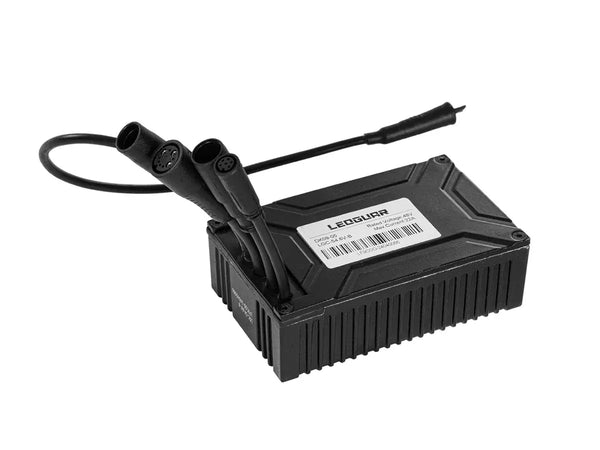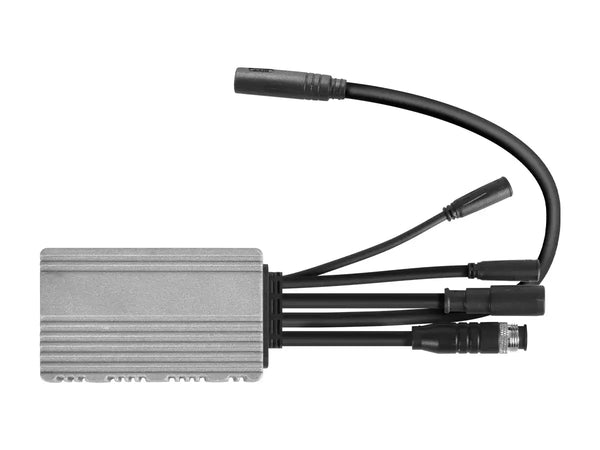
Ebike Controller: Can a 1000W Controller Run a 750W Motor?
Yes, you can run a 750W motor with a 1000W ebike controller. But the more important question is whether you should do it. The answer depends on your performance goals, the quality of your parts, and how well you understand the risks. An ebike controller works like the brain of your bike electrical system. Think of the controller as a gatekeeper that controls energy flow from your battery to your motor, not as a fixed power source. A 1000W controller can simply open that gate wider than a 750W controller. This guide will explain the technical reasons this works, the potential benefits, the safety risks, and a step-by-step process for those who want to make this upgrade.
Understanding Watts, Volts, and Amps
To understand why you can pair a 1000W ebike controller with a 750W motor, we need to explain the numbers first. The ratings on your e-bike parts aren't as strict as they might seem.
- Motor Wattage (like 750W): This number shows the motor's normal power rating. It's the amount of power the motor can handle all the time without getting too hot and breaking. Most good motors can handle peak power well above this normal rating for short times.
- Controller Wattage (like 1000W): This number describes the maximum power the ebike controller can give to the motor. It measures output capacity, not constant flow.
The relationship between these parts follows a simple formula: Volts x Amps = Watts. This is the basic relationship between voltage, current, and power that controls how your e-bike works.
- Voltage (V): Think of this as electrical "pressure" in the system. It's a fixed feature that must match between your battery, controller, and motor (like a 48V battery needs a 48V controller).
- Amperage (Amps/A): This is the electrical "current" or "flow." The controller actively manages this based on your throttle input.
- Wattage (W): This is the total power output, calculated by multiplying voltage and amperage.
A 1000W controller on a 48V system can deliver about 20-22 amps (48V x ~21A ≈ 1000W). A 750W controller on the same system delivers around 15-16 amps. The 1000W controller simply gives you access to higher amperage flow when you need it.

Benefits of Using a More Powerful Controller
So why would a rider choose to install a more powerful ebike controller than their motor rating suggests? The reasons go beyond just raw power and include reliability and future options.
First, you get more power and torque. A standard 750W motor is often strong enough to handle short bursts of 1000W or more. By using a 1000W controller, you can feed the motor more amps when needed. This creates a real performance boost: faster acceleration from a stop and much easier hill climbing. The motor won't run at 1000W constantly, only when you apply full throttle during high-demand situations.
Second, and maybe most important for long-term use, is better heat management and reliability. Heat is an ebike controller's biggest enemy, created when its internal parts called MOSFETs work hard. A 750W controller pushing a 750W motor up a long hill runs at 100% capacity. It will get very hot, increasing failure risk. A 1000W controller doing the same job only operates at 75% capacity. Its parts run much cooler, greatly reducing stress and leading to longer life.
Finally, installing a higher-wattage ebike controller offers future-proofing. It provides a clear upgrade path. If you later want more performance and buy a 1000W or 1500W motor, your controller is ready to handle it. This approach helps build a well-matched e-bike system that can grow with your needs.
Critical Risks to Your Motor
While the benefits sound good, pushing more power through your motor has significant risks. Being honest about what can go wrong is essential for making a safe choice. Ignoring these risks can turn an exciting upgrade into an expensive mistake.
The main risk is motor overheating. Constantly feeding a 750W motor with 1000W of power, especially during long, hard climbs, will create too much heat. A motor's normal rating exists for a reason—it's the heat limit for sustained use. Going beyond this limit leads to potential failures. Hub motors should work below 80-100°C. Once temperatures climb higher, especially above 120-150°C, the neodymium magnets inside the motor can permanently lose their magnetic strength. This causes permanent loss of torque and efficiency. In geared hub motors, the internal nylon gears can soften and melt, causing complete failure. The insulation on the motor's copper windings can also melt, causing an electrical short and total motor breakdown.
Even if you avoid a single catastrophic failure, consistently running the motor "hot" will greatly shorten its life. Heat damages all electronic and mechanical parts. Every ride that pushes the motor far beyond its heat comfort zone adds to wear and tear, breaking down its internal parts much faster than the manufacturer intended.
Also, the increased power draw strains other parts. Your battery's Battery Management System (BMS) must handle the higher amperage discharge. A battery designed for 15A continuous draw may struggle or shut down when a 1000W controller demands 22A. The physical drivetrain, including your chain and cassette, will also wear out faster from the increased torque.
Finally, using a mismatched, overpowered ebike controller will almost certainly void your motor warranty and possibly the entire e-bike system warranty. Manufacturers won't cover damage from non-standard setups.
Is This Upgrade Right for You?
Deciding whether to over-spec your ebike controller depends heavily on your riding style, technical confidence, and risk tolerance. To help you decide, we've created a simple decision framework. Find the profile that best matches your situation to understand the trade-offs. As experienced DIY builders often recommend, the right choice matches the hardware to your needs.
| Your Rider Profile | Risk Level | Potential Reward | Our Recommendation |
|---|---|---|---|
| Casual Commuter (Flat terrain, short trips) | Low | Low | Likely not worth the risk. A matched 750W controller is more reliable and efficient for your needs. |
| Enthusiast Rider (Mixed terrain, moderate hills) | Medium | Medium | A good option if you are technically confident. Gives a noticeable boost for hills without extreme risk if managed well. |
| Performance Seeker / Heavy Rider (Steep hills, heavy loads, off-road) | High | High | This is the primary use case. The extra power is very beneficial, but you must monitor heat and potentially program the controller. |
| DIY Builder (Building from scratch) | Varies | High | Excellent choice. A robust controller is a great foundation for a powerful and reliable build. You have full control over the setup. |
Safety and Setup Guide
If you've considered the pros and cons and decided that a 1000W ebike controller is right for your 750W motor, following a careful process is critical to minimize risk.
Disclaimer: Proceed at your own risk. This guide is for information only. If you're not confident in your technical abilities, please consult a professional e-bike mechanic.
Step 1: Check Voltage Compatibility. This is the most important and non-negotiable step. The voltage of your battery, controller, and motor must all match. If you have a 48V battery and a 48V motor, you must use a 48V electric bike controller. Mismatching voltage will instantly destroy components.
Step 2: Use the "Touch Test"-Your First Line of Defense. This simple, real-world test is your best tool for preventing heat damage. After a hard ride, especially one with a long, steep hill where you used full throttle, stop and carefully touch the center hub of your motor. It will be hot, but it should not be so hot that you can't keep your hand on it for three to five seconds. If it's burning to touch, you're pushing the motor too hard and risk permanent damage. You need to ease up on the throttle during long climbs or reduce the power settings on your controller.
Step 3: Program Your Controller (If Possible). Many aftermarket ebike controllers are programmable through their display or a computer interface. The most important setting to manage is the maximum current limit (often labeled "Max Current" or "Phase Current"). As discussed by riders in online communities, a conservative approach works best. Start by setting the max amps to a level that equals about 750-850W. For a 48V system, this would be around 16-18 amps (48V x 18A = 864W). From there, you can slowly increase the limit, always using the touch test after hard rides to ensure the motor stays within safe temperature range.
Step 4: Make Sure Your Wiring and Connectors Are Good Enough. Higher power means higher current flow. The stock wiring and connectors on your bike might not be rated for the increased amperage. Check your battery and motor phase wire connectors. Make sure they are high-quality connectors like XT60, XT90, or Anderson Powerpoles that can handle the 20+ amps your new controller can deliver.

Smart Power Over More Power
In conclusion, pairing a 1000W ebike controller with a 750W motor is not only possible but can be a highly effective upgrade when done correctly. The key is to change your thinking: the controller's wattage isn't what it outputs, but what it can output. You are in control.
The main benefit is not just more peak power, but a stronger and more reliable system that runs cooler under normal conditions. The critical risk is always heat. By actively watching your motor's temperature and using a programmable controller to set sensible limits, you can reduce this risk and find the perfect balance between performance and longevity.
The goal is to build a smarter, more capable system. A well-managed, slightly overpowered controller is often better than a stock controller that is constantly pushed to its limits. By understanding the principles of volts, amps, and watts, and respecting your motor's heat limits, you can safely unlock a new level of performance from your e-bike. Ride smart, and ride safe.
Frequently Asked Questions
Q: Will a 1000W controller damage my 750W motor immediately?
A: No, it won't damage your motor immediately if used properly. The motor can handle short bursts of higher power. However, consistently running at maximum power for long periods can cause overheating and permanent damage. Monitor your motor temperature and use the touch test after hard rides.
Q: Can I use any 1000W controller with my 750W motor?
A: No, the voltage must match exactly. If you have a 48V motor and battery, you must use a 48V controller. The wattage can be higher, but voltage mismatch will instantly destroy your components. Also ensure your controller is compatible with your motor type (brushless, hall sensors, etc.).
Q: How do I know if my motor is getting too hot?
A: Use the touch test after riding. If you can't keep your hand on the motor hub for 3-5 seconds, it's too hot. Ideal operating temperature is below 80-100°C. If your motor feels scalding hot, reduce throttle use on long climbs or lower your controller's power settings.
Q: Will this upgrade void my warranty?
A: Yes, using a mismatched controller will almost certainly void your motor and possibly your entire e-bike warranty. Manufacturers don't cover damage from non-standard configurations. Consider this carefully before proceeding with the upgrade.
Q: What's the best way to start this upgrade safely?
A: Start conservatively by programming your 1000W controller to limit current to 750-850W equivalent (16-18 amps on 48V). Gradually increase power while monitoring motor temperature. Ensure all your wiring and connectors can handle the higher amperage. If you're not technically confident, consult a professional e-bike mechanic.












































Leave a comment